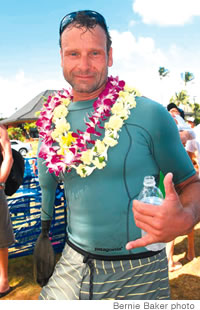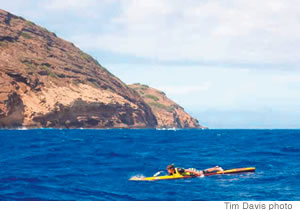Conquering Kaiwi Channel — Again

Jeff Denholm
The ocean is where Jeff Denholm escapes and finds comfort from the daily grinds of life. It’s also the venue where he pushes his body and mind to the limit.
Denholm survived a traumatic injury 17 years ago while working as a deck-hand in the Bering Sea. A large wave knocked him off balance and his right arm hit a drive shaft. His dominant arm suffered extensive damage and was amputated just below the shoulder.
It was an injury that altered his life but not his will to live life to its fullest. The lifelong athlete never stalled in his pursuit of maintaining an active and competitive lifestyle. But there were adjustments.
Denholm’s injury forced him to develop tools in order for him to “respectively compete” against world-class athletes. One of those sports is paddle-board racing.
In order to perform, Denholm uses a prosthetic arm equipped with a paddle that is attached to the end of his four-and-a-half inches of revised limb. Because most of his power comes from one side, his imbalance in muscle strength requires continuous maintenance.
“When I get the right rhythm, I feel like I have two arms,” says Denholm, who started paddleboard racing to stay in shape in order to catch waves while one-arm surfing.

Amputee Jeff Denholm finished the 2010 Molokai to Oahu paddleboard race in 7:49:10
His latest challenge came on July 25 when the 43-year-old Denholm competed in his second Molokaito-Oahu paddleboard race, shaving more than 20 minutes off his time in 2009.
Last year, 15 miles into the 32-mile race, Denholm says the arm failed after the device malfunctioned. For the next 17 miles he basically “one-armed it,” finishing in a time of 8:09:46.
It was an effort that brought him to tears.
It also was an effort that made him return to the drawing board to refine his high-tech prosthetic arm. He found a new adhesive and trained harder, four days a week, logging between 20 and 30 miles every week.
“With the full use of only one arm I have to be very careful about over-training,” says Denholm. “I add a lot of stretching and yoga into the mix with two days a week of intense cross-training circuit-type workouts with a personal trainer as well.”
The hard work paid off, and so did the equipment adjustment. Denholm finished the 2010 challenge in 7:49:10, more than 20 minutes faster than his first crossing.
“I have an immense amount of respect for any race of the Molokai’s distance,” says Denholm. “Anything can happen. For me, the biggest X factor is my paddling device. I glue it to what is left of my arm and both the glue and device have proven to fail over long-course races. If it stays on, I am confident in my physical ability and feel that I can perform quite well. If it fails, it will be all about survival at that point.”
Denholm has done more than just survive. He has inspired many people with his life story and personal drive to succeed. He’s expected to return to Hawaii in 2011 to compete with the world’s elite once again.
You must be logged in to post a comment.




There are no comments
Add yours